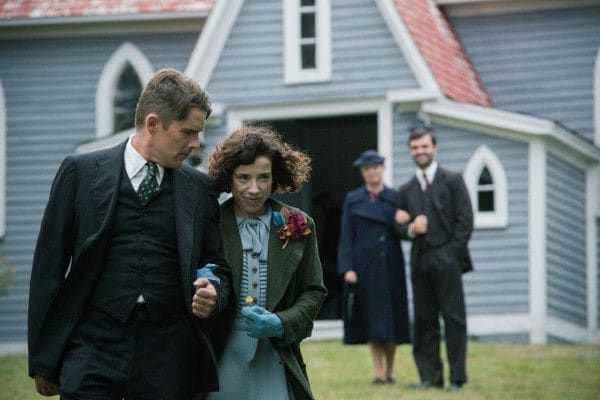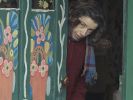Eye For Film >> Movies >> Maudie (2016) Film Review
Maudie
Reviewed by: Anne-Katrin Titze

Canadian Folk Artist Maud Lewis painted a world of kittens, tulips and reindeer, of butterflies, lumberjacks and snowflakes in July. Aisling Walsh's Maudie, with a screenplay by Sherry White, scratches the outwardly wide-eyed surface of paint and discovers layers of pain, sacrifice and the cost of survival. Maud, who suffered from juvenile arthritis since her youth, is played with flinty physical awareness by Sally Hawkins and Ethan Hawke as her husband Everett gives one of his most nuanced performances.
After the parents' death, Maud's good-for-nothing brother Charles (Zachary Bennett) sells the family house without her knowledge or consent. She is left to live with her aunt Ida (Gabrielle Rose), a woman who nourishes herself with village gossip and starves her soul with what people will say. She is a rather typical specimen of small-town malice and disappointment, as common in the Thirties as it is now. It is the brother, though, who, driven by greed, we surmise, committed an unforgivable sale and betrayal.

Maud, not prone to giving up, answers an ad put up at the local grocery store by Everett, a loner who grew up in an orphanage and lives off selling fish and taking on odd jobs in his small habitat not far from the sea. We are in rural Nova Scotia and the wild beauty of the landscape does, at least for the eye, lessen the harshness of life a little.
Everett wants a woman to clean up his messes. He growls and mumbles at the strange bird that landed in his lap. His meanness is of nobler quality than that of her family. It is fear, not spite, that makes him say the things he says. "First come the dogs, then the chickens, and then you" is not merely meant to hurt Maud. These are the rules he thinks he needs to make order in his sparse, cold life. In Paul King's Paddington it is Sally Hawkins' character who holds the world together. The same is true in Maudie as she sees the big picture of her relationship with Everett.
The small hovel without running water or electricity (that stands now in a museum in Halifax, Nova Scotia) was the couple's home their entire life together. Without having to rely on sentimental escapism, one could say that these "odd socks" make more sense as a couple than much of what is presented as becoming a relationship in most mainstream Hollywood fare.
Slowly - and Walsh is particularly good with time - their relationship shifts and the hut changes into a compact wonderland of colour and delight because Maud discovers painting. Bright and lovely with a logic totally her own, things transform. Sandra (Kari Matchett), a woman on vacation from New York, by a coincidence concerning undelivered fish, discovers the artist and becomes Maud's friend.
That their friendship is real shows itself in a moment of great need. The rhythm of Sandra's speech resembles that of Katharine Hepburn and she is the only one in the film whose clothes help us navigate the time period we are in. The performances under Walsh's direction capture the fine splinters of motivation and the mystery that we all are to each other.
That artistic creation can save lives, that much is certain. Which hell is less hellish? They might ask themselves no less difficult a question and then give that path their all.
Reviewed on: 13 Jun 2017
















